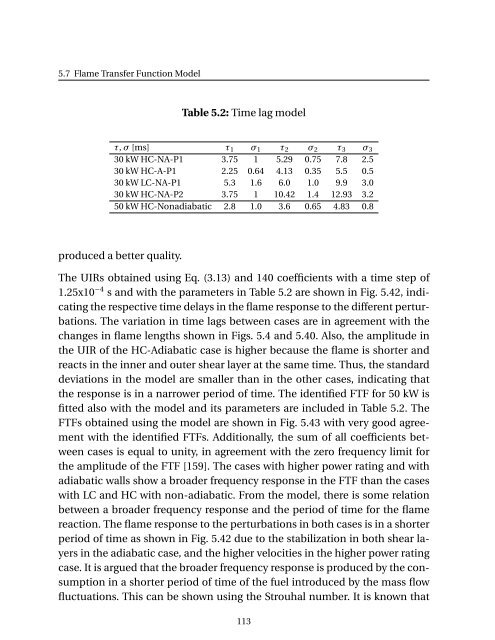Numerical Simulation of the Dynamics of Turbulent Swirling Flames
Numerical Simulation of the Dynamics of Turbulent Swirling Flames
Numerical Simulation of the Dynamics of Turbulent Swirling Flames
You also want an ePaper? Increase the reach of your titles
YUMPU automatically turns print PDFs into web optimized ePapers that Google loves.
5.7 Flame Transfer Function Model<br />
Table 5.2: Time lag model<br />
τ, σ [ms] τ 1 σ 1 τ 2 σ 2 τ 3 σ 3<br />
30 kW HC-NA-P1 3.75 1 5.29 0.75 7.8 2.5<br />
30 kW HC-A-P1 2.25 0.64 4.13 0.35 5.5 0.5<br />
30 kW LC-NA-P1 5.3 1.6 6.0 1.0 9.9 3.0<br />
30 kW HC-NA-P2 3.75 1 10.42 1.4 12.93 3.2<br />
50 kW HC-Nonadiabatic 2.8 1.0 3.6 0.65 4.83 0.8<br />
produced a better quality.<br />
The UIRs obtained using Eq. (3.13) and 140 coefficients with a time step <strong>of</strong><br />
1.25x10 −4 s and with <strong>the</strong> parameters in Table 5.2 are shown in Fig. 5.42, indicating<br />
<strong>the</strong> respective time delays in <strong>the</strong> flame response to <strong>the</strong> different perturbations.<br />
The variation in time lags between cases are in agreement with <strong>the</strong><br />
changes in flame lengths shown in Figs. 5.4 and 5.40. Also, <strong>the</strong> amplitude in<br />
<strong>the</strong> UIR <strong>of</strong> <strong>the</strong> HC-Adiabatic case is higher because <strong>the</strong> flame is shorter and<br />
reacts in <strong>the</strong> inner and outer shear layer at <strong>the</strong> same time. Thus, <strong>the</strong> standard<br />
deviations in <strong>the</strong> model are smaller than in <strong>the</strong> o<strong>the</strong>r cases, indicating that<br />
<strong>the</strong> response is in a narrower period <strong>of</strong> time. The identified FTF for 50 kW is<br />
fitted also with <strong>the</strong> model and its parameters are included in Table 5.2. The<br />
FTFs obtained using <strong>the</strong> model are shown in Fig. 5.43 with very good agreement<br />
with <strong>the</strong> identified FTFs. Additionally, <strong>the</strong> sum <strong>of</strong> all coefficients between<br />
cases is equal to unity, in agreement with <strong>the</strong> zero frequency limit for<br />
<strong>the</strong> amplitude <strong>of</strong> <strong>the</strong> FTF [159]. The cases with higher power rating and with<br />
adiabatic walls show a broader frequency response in <strong>the</strong> FTF than <strong>the</strong> cases<br />
with LC and HC with non-adiabatic. From <strong>the</strong> model, <strong>the</strong>re is some relation<br />
between a broader frequency response and <strong>the</strong> period <strong>of</strong> time for <strong>the</strong> flame<br />
reaction. The flame response to <strong>the</strong> perturbations in both cases is in a shorter<br />
period <strong>of</strong> time as shown in Fig. 5.42 due to <strong>the</strong> stabilization in both shear layers<br />
in <strong>the</strong> adiabatic case, and <strong>the</strong> higher velocities in <strong>the</strong> higher power rating<br />
case. It is argued that <strong>the</strong> broader frequency response is produced by <strong>the</strong> consumption<br />
in a shorter period <strong>of</strong> time <strong>of</strong> <strong>the</strong> fuel introduced by <strong>the</strong> mass flow<br />
fluctuations. This can be shown using <strong>the</strong> Strouhal number. It is known that<br />
113
















